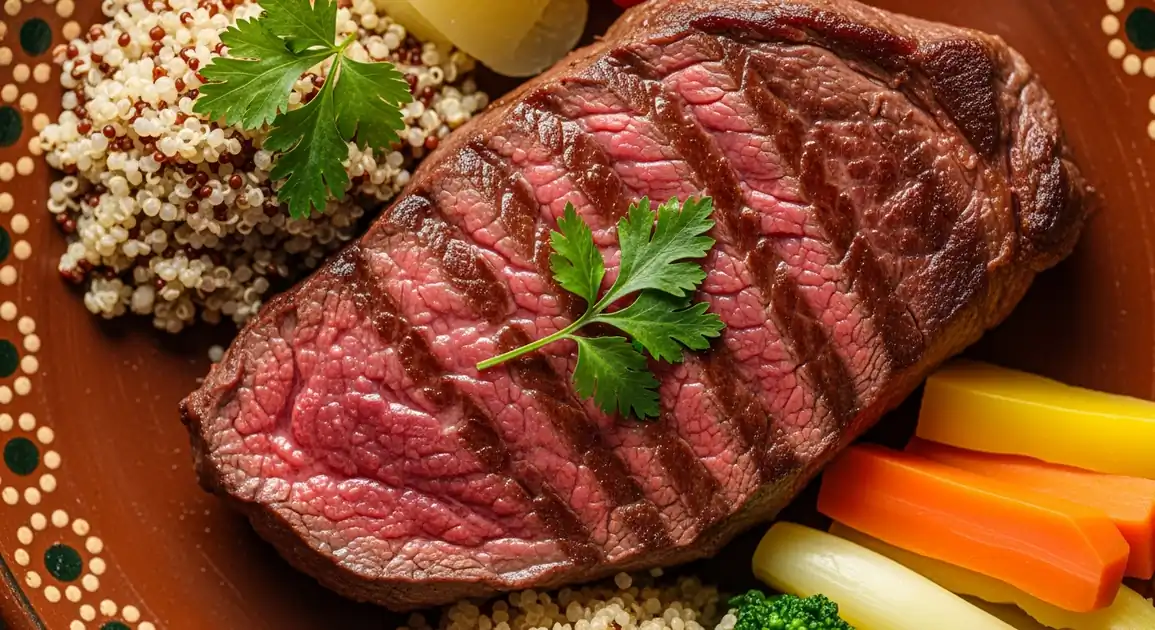Alpaca Steak
Bistec de Alpaca

Description
Cusco, the historic capital of the Inca Empire, offers perhaps the finest alpaca steak experiences in Peru. Situated in the heart of the Andes at 3,400 meters elevation, the city combines traditional Andean culinary knowledge with modern restaurant practices. Alpaca steak has become a signature dish for tourists seeking authentic local cuisine, available from rustic picanterías to sophisticated restaurants specializing in novo-Andina cuisine.
Dietary Information
Serving information
Serving style
In Cusco restaurants, presentation ranges from rustic to elegant depending on the establishment. Typically served on warm plates with colorful Andean sides. Often garnished with native herbs and sometimes edible flowers. Frequently accompanied by a sauce, which might include local ingredients like aguaymanto, rocoto pepper, or huacatay.
Quick facts
Lunch service typically runs from 12 PM - 3 PM, with dinner from 6 PM - 10 PM. Some tourist-oriented restaurants may serve continuously throughout the afternoon.
Safety Tips
What to Look For
-
Proper cooking temperature
Alpaca should be cooked to at least medium (internal temperature of 145°F/63°C) to ensure food safety while maintaining tenderness.
-
Clean, reputable establishments
Choose restaurants with good hygiene standards, ideally those recommended in guides or with positive reviews from other travelers.
-
Freshly prepared meat
The meat should be served hot and freshly prepared, not reheated or sitting under warmers.
-
Proper meat color
Cooked alpaca should have a caramelized exterior and be pinkish-brown to light brown inside, not red or raw-looking.
What to avoid
-
Very rare or raw alpaca
Unlike beef, alpaca should never be consumed rare or raw due to the risk of parasites or bacteria.
-
Suspiciously low prices
Extremely cheap alpaca dishes might indicate poor quality meat or potentially substituted meat (like llama or even beef).
-
Strong gamey or ammonia smell
Fresh alpaca has a mild aroma; strong odors indicate poor quality or improper storage.
-
Street vendors selling alpaca
Alpaca requires proper refrigeration and cooking equipment; it's rarely sold safely by street vendors.
Price information
Price range
Budget tips
- Restaurants in the San Blas neighborhood often offer better value than those directly on Plaza de Armas.
- Lunch menus ('menú del día') sometimes include alpaca dishes at 25-40 PEN, compared to 50-85 PEN for dinner.
- Restaurants on side streets like Calle Procuradores or Calle Plateros often have more reasonable prices than those with plaza views.
- Some picanterías in the San Jerónimo and San Sebastián districts offer authentic alpaca dishes at lower prices.
Value indicators
- Restaurant reputation among locals, not just tourists.
- Proper identification as alpaca on the menu (not generic 'exotic meat').
- Served with authentic Andean accompaniments like native potatoes or quinoa.
- Proper cooking technique showing caramelization while maintaining tenderness.
Where to Find This Dish
Historic Center
Highest concentration of restaurants serving alpaca steak, particularly around Plaza de Armas and adjacent streets.
Plaza de Armas, Calle Plateros, Calle Procuradores
Dinner (6 PM - 10 PM)
San Blas
Bohemian neighborhood with charming restaurants offering quality alpaca in more intimate settings.
Plaza San Blas, Calle Carmen Alto
Dinner (6 PM - 9:30 PM)
San Pedro
Area around the market with more authentic, local-oriented eateries.
Mercado San Pedro, Calle Cascaparo
Lunch (12 PM - 3 PM)
Avenida Sol
Major avenue with several established restaurants serving alpaca.
Qorikancha (Temple of the Sun), Avenida El Sol
Lunch and Dinner (12 PM - 10 PM)
Vendor Tips
- Restaurants displaying the 'Q'ewar' quality seal ensure adherence to local culinary standards.
- Ask for recommendations for 'the best alpaca' from local hotel staff or guides rather than following only tourist guides.
- Look for transparency about sourcing—quality restaurants will know where their alpaca comes from.
- Avoid places that seem uncertain whether they serve alpaca or llama, as this suggests questionable sourcing.
How to Order
Regional Variations
-
Novo-Andina Style
(Estilo Novo-Andino)
Modern interpretation featuring precise cooking techniques, artistic presentation, and creative sauces using native ingredients like aguaymanto, elderberry, or coca.
-
Traditional Cusco Style
(Estilo Cusqueño Tradicional)
Simpler preparation emphasizing the meat's natural flavor, often seasoned with local herbs like muña or huacatay, served with native potatoes and corn.
-
Fusion Preparations
(Preparaciones Fusión)
Some Cusco restaurants incorporate alpaca into international dishes, creating novel options like alpaca burgers, carpaccio, or even alpaca sushi.
-
Alpaca with Altitude Herbs
(Alpaca con Hierbas de Altura)
Distinctive Cusco preparation using aromatic herbs that only grow at high altitudes in the region, creating a unique local flavor profile.
Cultural context
History
Alpacas have been domesticated in the Peruvian Andes for over 6,000 years, primarily for their fine wool. Historically, their meat was consumed during special occasions or when animals were culled from the herd. While indigenous communities have long included alpaca in their diet, its preparation as a steak (bistec) catering to international tastes is a more recent development, coinciding with the growth of tourism in Peru and the emergence of novo-Andina cuisine that reinterprets traditional ingredients with modern cooking techniques.
Local significance
In Cusco, alpaca represents both the region's indigenous heritage and its modern culinary evolution. While traditionally consumed in rural communities, it has become emblematic of Cusco's identity as the center of Andean culture.
Eating customs
- Traditionally paired with chicha morada (purple corn drink) or local corn beer.
- In Cusco, it's common to enjoy alpaca as part of a sampling of Andean meats, sometimes alongside guinea pig (cuy) or trout.
- Locals typically prefer alpaca cooked medium to well, while restaurants often accommodate tourists' preferences for medium-rare.